Turn on suggestions
Auto-suggest helps you quickly narrow down your search results by suggesting possible matches as you type.
Showing results for
- Good Sam Community
- Groups
- Travel Trailer Group
- Forum
- Re: Two For Texas: A Tale of a 3,000 mile journey
Options
- Subscribe to RSS Feed
- Mark Topic as New
- Mark Topic as Read
- Float this Topic for Current User
- Bookmark
- Subscribe
- Mute
- Printer Friendly Page
Two For Texas: A Tale of a 3,000 mile journey
Options
- Mark as New
- Bookmark
- Subscribe
- Mute
- Subscribe to RSS Feed
- Permalink
- Report Inappropriate Content
Dec-03-2013 10:18 AM
This is an epic tale of how Jane and I decided to take a long trip in the renovated Avion truck camper over Thanksgiving.
We were interested in some property in far west Texas, and our family was gathering in New Orleans for the holidays. Jane is an elected public official and has to be at City Council meetings every 2-3 weeks, so we seldom have much time for travel. When we plotted out the schedule, it appeared that we were going to cover some 3,000 miles in roughly two weeks. That seemed formidable. After all, the longest trip we've taken with the restored camper was four days, and that was within 200 miles of home. This promised to be an uncompromising shakedown of the truck camper. If anything were to go wrong we would be far from home.
But long range weather forecasts looked good, the property in Texas looked promising, and we remain eternal optimists. Off we went.
The first day was almost 12 hours driving. We arrived at our first destination, Wright Patman Reservoir near Texarkana, Texas. Though we had reservations with the Corps of Engineers RV site, we didn't have a map of the place and wound up driving around in the darkening night. A friendly fisherman actually guided us to our site, otherwise we would have boondocked on someone's dam. Dinner was delicious as was breakfast. One of our agreements on the trip is that we would perform traditional gender roles: Jane was in charge of anything to do with food, furnishings and interiors…I was the mechanic, driver and outside guy. Being a modern feminist, Jane usually rejects this reasoning, but we found it to work very well on the trip. I thought at one point of suggesting that we continue this arrangement in the future. Then my better sense took over…
In the morning I awakened before dawn. The waters in the reservoir were gleaming in the morning light. Things looked promising.

We drove on I 30 through Texas. For those of you who haven't driven in Texas, the freeway has a 75MPH speed limit. And that is just a starting point. Unbelievably the farm roads were posted in many cases at 70MPH.
I had not driven the Avion truck camper for long distances, but I was very favorably impressed. Even at the high speeds, the rig worked well. While I have airbags and other mods for stability, I was struck over and over as to the aerodynamic qualities of the Avion. I have been in flat sided TCs that seemed to be sucked in by passing tractor trailers…swerving all over the road. That did not happen with us.
However, I must warm you that one DOES NOT take advantage of the HOV lanes in Dallas-Fort Worth during morning rush hour. Jane and I still refer to it as the CANYON OF DEATH. It was entirely my fault, as I swerved into the HOV lane, not noticing that it was guarded on both sides by concrete barriers and that the lane dropped off about two inches on either side of the roadway. It was white knuckle time for many miles.
We passed through the oil rich Permian Basin. Unless you've been on another planet, you know by now that there is something called "fracking" going on. However, unless you've been to a fracking area you have no idea how intense the activity is. I mean 24/ 7/ 365, big men with big trucks and fracking wells all over.
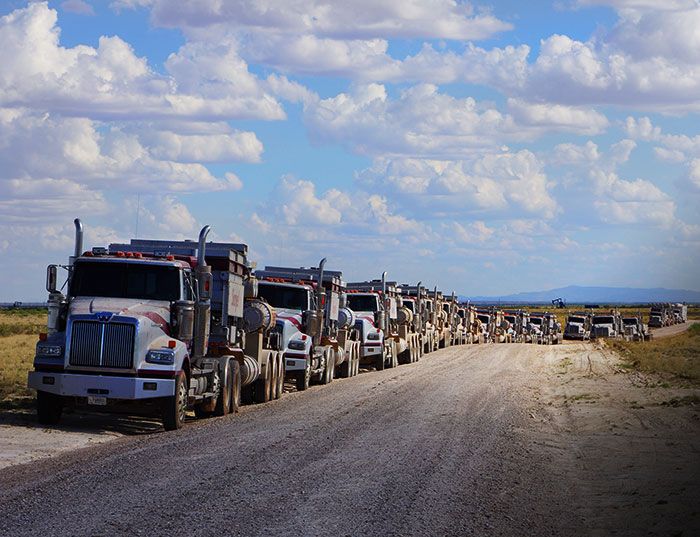
It's hard to contemplate the wealth that is being generated, though you can see the houses going up alongside the road. I mean, not in a grand location with lakes, etc. Just along the road - with a heliport in the back yard. This is Texas!
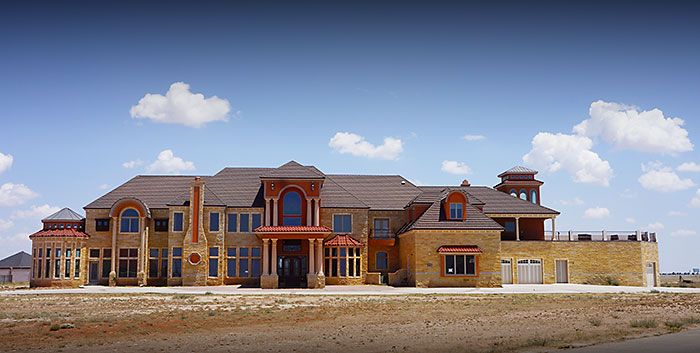
We arrived at our campground southwest of Midland-Odessa, Monahan's Sandhill State Park, before dusk. It was largely empty, so we found our spot and reflected on our luck. It was warm, with a gentle breeze. We ate grilled salmon outside. Let me assure you all that the Texas Parks are superb. The best system that I have seen anywhere. So, we looked forward to a restful night and a good start in the AM.
In the morning I awakened to a beautiful red sky. Completely innocent of weather knowledge I went about my business.
It turns out there is an old saying: "Red skies in the morning, sailor's warning."
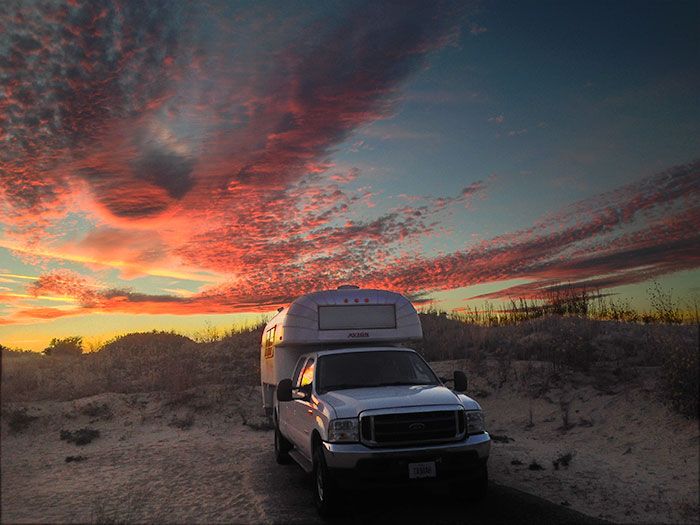
We drove towards our destination of Marfa, Texas. The winds were picking up. The realtor in Marfa emailed that they were expecting a severe winter storm that night.
Marfa is a strange phenomenon in the far west Texas mountain country. It's a town of perhaps 3,000 people that has been transformed into an outpost of Brooklyn or Los Angeles. The primary attraction is the the sculpture of Don Judd, who died 20 years ago. Judd purchased half the town as well as an abandoned Army base where he installed his work and that of other artists. Judd was a "minimalist" - who objected to the term, of course. I tend to be attracted to the aesthetic dimensions of minimalism - a profoundly direct approach to materials and ideas. So, the experience for me was very powerful. In addition to Judd's work there is also Dan Flavin's neon sculptures among other artists. The town has galleries and restaurants, but its largely shut down for the first few days of the week. If you go, make sure you eat at the Food Shark. It's a food truck that is open under the pavilion in the middle of town.
Marfa is at least 4 hours away from a city. So, you have to make it a destination. We've become intrigued with the town - and thought that we might find a place for part of the year that would also be a good investment.
Here is Judd's installation at the Army Base. There are many more sculptures outside - the guided tour that includes his home, studio, and other sculptors works, takes much of the day.
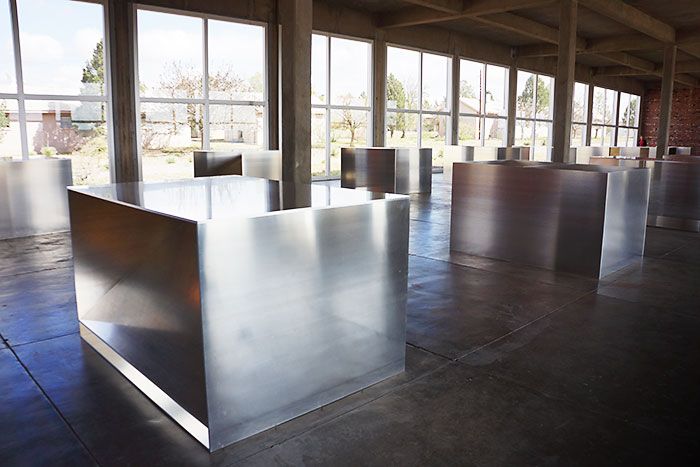
Dan Flavin's sculptures

Oddly enough, this out-of-the-way town is where "Giant" was filmed with James Dean, Elizabeth Taylor and Rock Hudson. Recently it has been the site of award winning films like "No Country for Old Men" and "There Will be Blood". Everyone in the movies, including the cast of Giant stayed at the Paisano Hotel. This is the lobby where a good libation can be had. That's my sweet daughter, who lives in Berlin, relaxing last May.
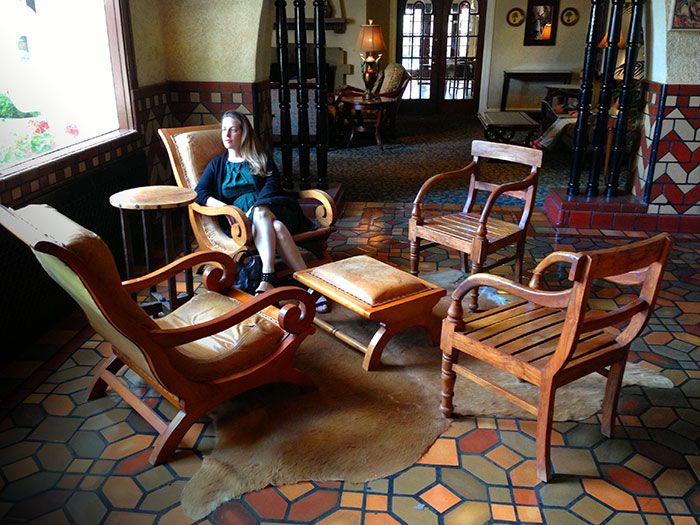
We arrived in Marfa during the day and looked at properties, met with city officials about taxes, etc…all the stuff you do when you're checking out real estate. All day long it cooled, and the temperature lowered. We were busy and didn't pay much attention. We checked into the hipster RV park on the outskirts of Marfa. The winds blew and blew. The heavens howled.
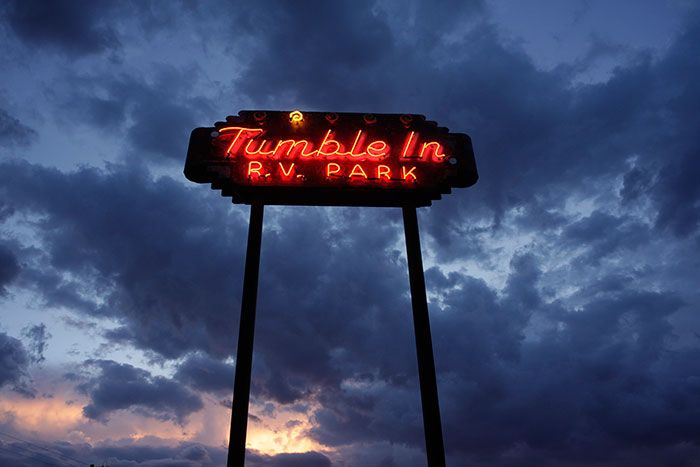
The sleet hit the aluminum Avion like bb's from a shotgun. The wind pushed us back and forth all night. Two things happened that were unanticipated: (1) the Wave 3 heater appeared to only heat up a small amount - just the bottom. And (2) the CO/propane detector went off constantly…no matter what we did. We opened and closed windows. Turned the Wave up and down.
I was thinking that we really hadn't used the heater in a long time and perhaps it had gotten dusty or whatever. But, it didn't matter. We were caught in an ice storm with little heat. I thought of disengaging the detector - maybe something was wrong with it - then I had another thought - better to leave the detector running in case its right than to disarm it - and not find out it was right. I was pleased with my sharp thinking…..

Finally we got into bed with the wonderful goosedown comforters that Jane had brought and rode out the night. it was like being in a tempest in a sailboat. In the morning we got up extra early and headed south to the Mexican border. Unfortunately, there are several high mountains where ice was collecting. The truck started to slide slightly as we neared the passes. I went into 4 wheel drive and creeped along. If we didn't get over the pass we had to return to Marfa where the storm was gathering strength. We might be iced in for days.
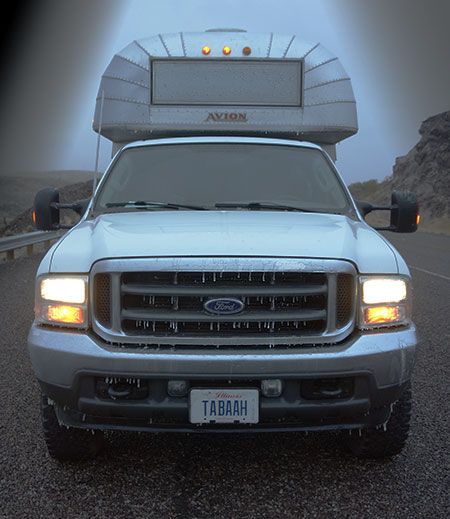
We made it Presidio on the Mexican border. It was relatively warm. We decided that it was time to have some huevos rancheros. And yes, they were very good.

We have always been intrigued by the Mexican border. Over the past few years the issue of illegal immigration has been an important topic. Marfa is the center for the Border Patrol and you can see the white vans and trucks everywhere on the landscape. So, we were a little concerned that tooling along the Rio Grande in our Avion camper might be interpreted by the Border Patrol as suspicious activity. We could be carrying a dozen illegals in the camper - or maybe something else. It sort of rattled me to contemplate rap on the door and for the Feds to ask for "your papers, please".
Texas 170 goes alongside the Rio Grande on its way to Big Bend National Park from Presidio. Now there is actually a little confusion: There is also a Big Bend Ranch State Park that runs alongside the Rio Grande and abuts the Federal Big Bend national Park. We didn't go into Big Bend Ranch, but from all accounts it is very primitive and wonderful. The expanse of the two parks together is larger than many of the states in the US, and the danger of this isolation is also big. It seems that every week someone gets lost for days or worse. Its a place to take some care. We took Texas 170 and wondered at the beauty of the area. We were also relieved to leave the storm behind. Jane had always wanted to dip her foot in the Rio Grande, so here was the opportunity:

That's the border folks, and not a Border Patrol guy in sight. In fact all through the Park and for several hundred miles we didn't see any of the ICE guys. Please note the nice green patch across the Rio Grande…that's Mexico.
We made it into Big Bend, but we noted that the weather was cooling again. Without our internet connections, and the radio given over to mostly mariachi, we didn't know what was happening with the storm. But who's worry about that when you're driving through Big Bend country. Its downright amazing.
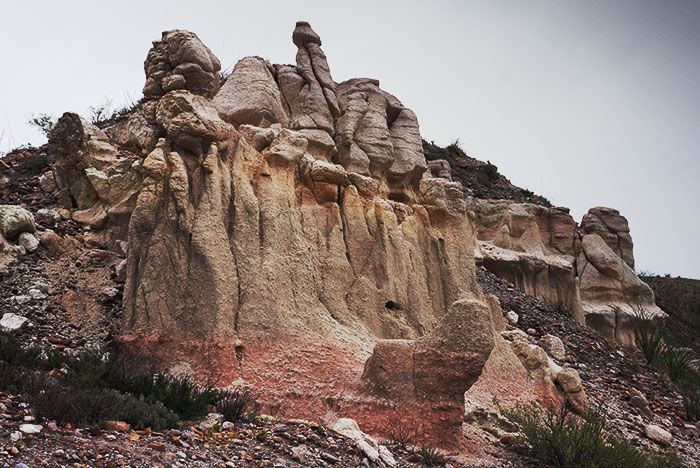
Huge vistas that photography can't easily convey.
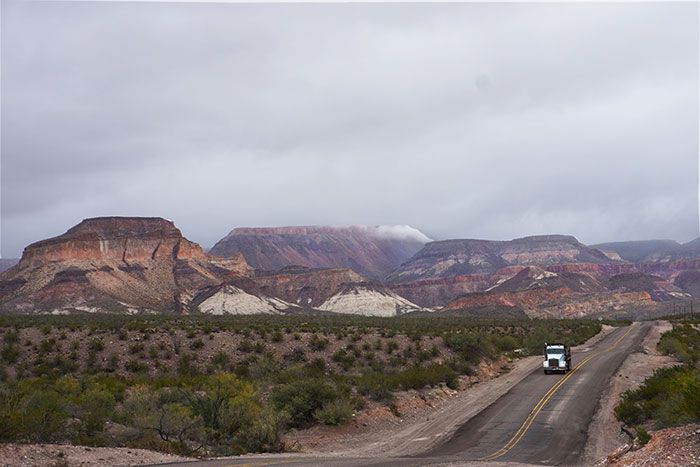
We drove into the town of Terlingua. It's the scene of the world famous chili "cook off" the first week of November. Seems like there was a disagreement between the pro-bean Chili folks and the anti-bean Chili Folks. So, the cook offs are now two distinct events. Too bad we missed it, but it appears that the year's DUI arrests spike in the first week of November. Better that we are here in the last week of November.
I didn't know that the area was opened up in the late 1800s as a result of Mercury mining - "Quicksilver" or "Cinnabar". I think that Mercury contamination can make you crazy. That may explain some of the purported goings on in Terlingua.
We settled down for the night after driving towards Cottonwood and passing the old mining area of Castolon and the sheer walls of Santa Elena Canyon. We were the only ones at Cottonwood Campground. I sort of wondered where everyone was…
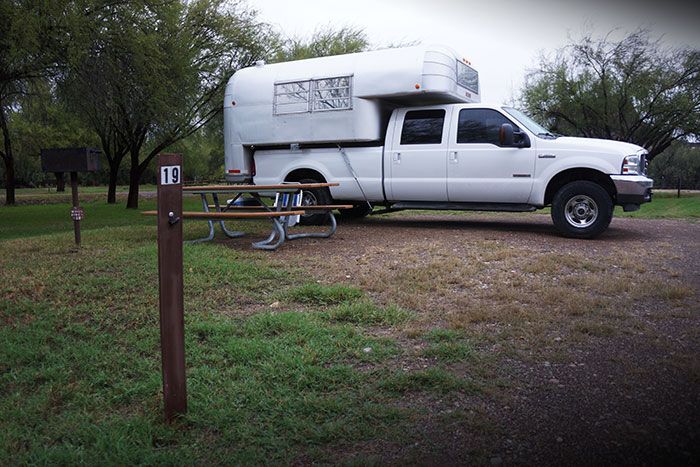
That evening, towards dusk, there were three sharp raps on the side of our camper. We couldn't see anyone through the windows. We called out but no one answered. We called again. Of course we had two thoughts: (1) Some illegal immigrants have come across the Rio Grande and they were inviting themselves to dinner or (2) ICE is outside the camper and wants to "see our papers" and inspect the camper. I wanted to go first through the door, sheltering Jane. Of course, Jane, abandoning our agreement about the roles of gender threw the door open first and said, "Who's there?". It turned out to be be an officious National Parks guy who had issues with our paperwork. Jane had packaged our fees correctly, had written up the permits correctly, but had not affixed them to the window correctly. What was a National Parks guy to do in a deserted campground with this level of incompetence? Jane who holds a PhD and the National Parks guy discussed the issue minutely. Finally he was satisfied and left.
We woke up in the morning to a winter wonderland, deep in the heart of Big Bend.

The storm had caught us. We were the only ones who didn't figure it out it appeared. We broke camp and headed for high ground and then to the east with the storm right behind us.
We passed over the Pecos River and the dizzying bridge.

We arrived at Seminole Canyon State Park. We had hoped to see the well known Indian Pictographs that would dazzle Whazoo. It was not to be. The storm made the footing too slippery to travel in the canyon. And to add insult to injury, there was no place within 50 miles to buy a beer or a bottle of wine. Jane cooked a great meal as usual, but here we were alone in a campground, buffeted again by the storms and nothing to ease the pain… I reflected that Silversands would have never allowed this situation to develop. Drat!
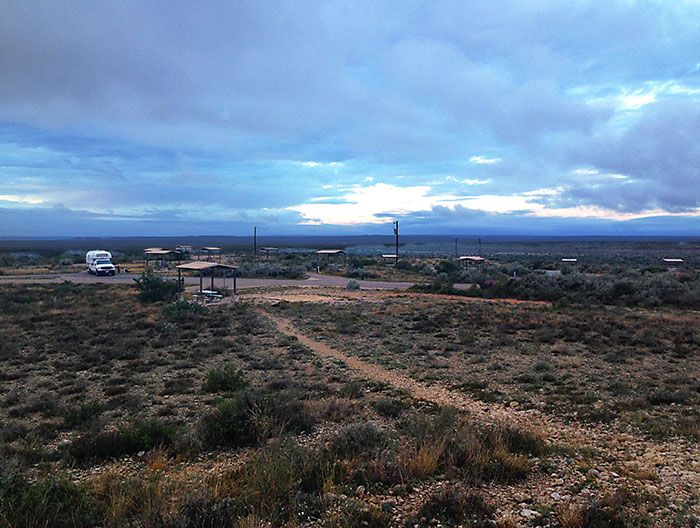
On to Goose Island! We traveled to Corpus Christie, Texas the next day on our way to Goose Island State Park. We have both been intrigued by the WPA in the Roosevelt administration and the parks that were created by the Civilian Conservation Corps. The CCC was made up of young out of work men. They lived in military style barracks while working on parks and other construction. Interestingly, most of their pay was sent home to their mama's…a very good idea according to Jane. The Texas Park system was largely started during the Depression and the CCC. They have a special website devoted to the CCC Parks, and Goose Island is one of them. Its in the bay near Corpus Christie and the Aransas Wildlife Preserve that is famous for the Whooping Cranes.
It was cold on Goose Island, but better than the day before. Besides, I had scored wine from a liquor store. Ahem. It's against the rules of the park, but I figured I was a senior citizen and adept at turning wine into water. So, I thought I deserved special privileges.
Our spot was right on the Bay.
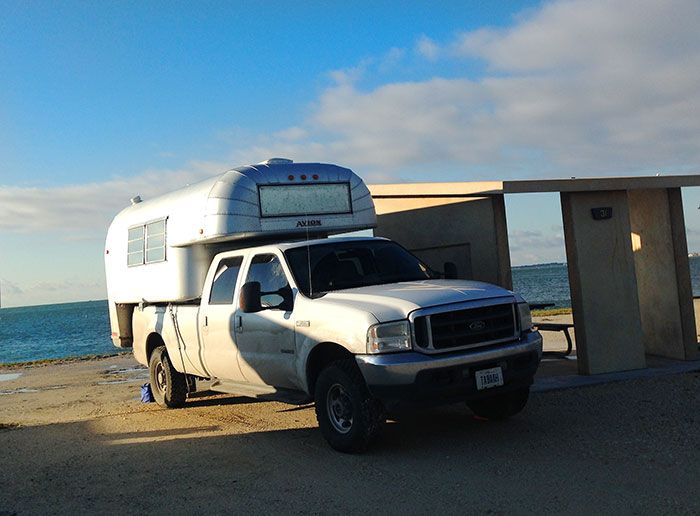
We went in the morning to the Aransas Wildlife Preserve. Turns out the headquarters was closed. Not only that, but yet another officious Federal parks guy directs us to put our money into a slot in the building. I sort of questioned our donation to a closed facility, but we went ahead and did it. After all, I was in a better mode having a pleasant dinner with my companion, Cabernet Sauvignon. With no maps and no info we went looking for the elusive Whooping Crane. Yet again, we were alone. The trees on Aransas had been sculpted by the continuous winds.
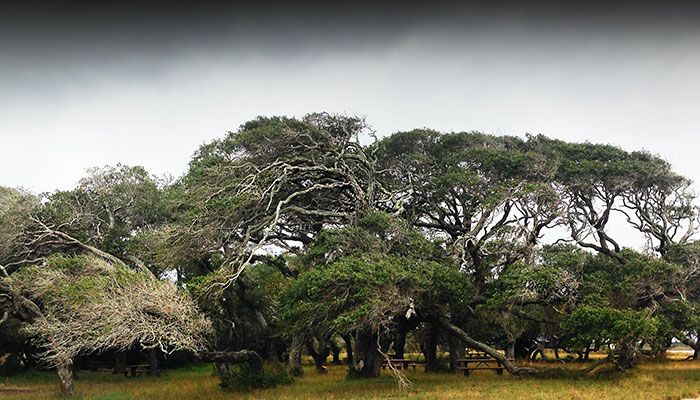
We spotted a strange contraption of a walk way that took us over the tree tops in our effort to spot the Whooping Crane. We peered here and there with our binoculars. The Whooping Crane story is the Ur story of wildlife preservation. It was almost extinct, along with the Sand Hill Crane, in the middle of the last century. Tremendous efforts were made at preserving these birds and gradually their flocks grew. Now, they travel to Aransas in the winter ahead of the storms to make their home. Ahead of the storms? A Ha! I told Jane to keep a close look out. Mind you we were completely alone on a day that the park was essentially closed…and what did we see? We saw a pair of Whooping Cranes floating in the sky and landing nearby.
Ha. Usually the tourists have to pay some dude in a boat $100 for the "wildlife tour" to see the Cranes. This picture is from the Aransas website.
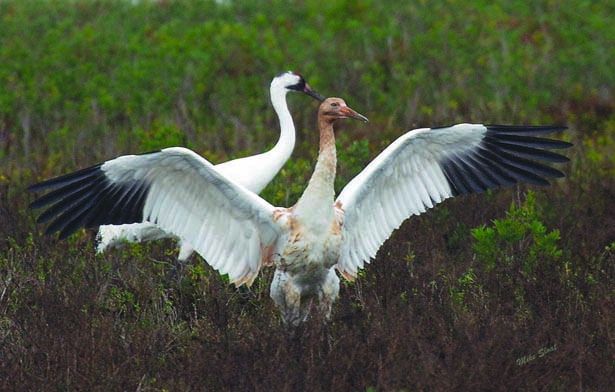
Traveling along the Texas Coast we entered the town of Palacios. I saw brightly colored shrimp boats and recalled to Jane that I remember that Vietnamese fishermen had settled on the Gulf coast after escaping the Communist regime in Vietnam. They started fishing for shrimp which, ironically, led to gunfights at sea with Ku Klux Klansmen over disputed fishing waters.
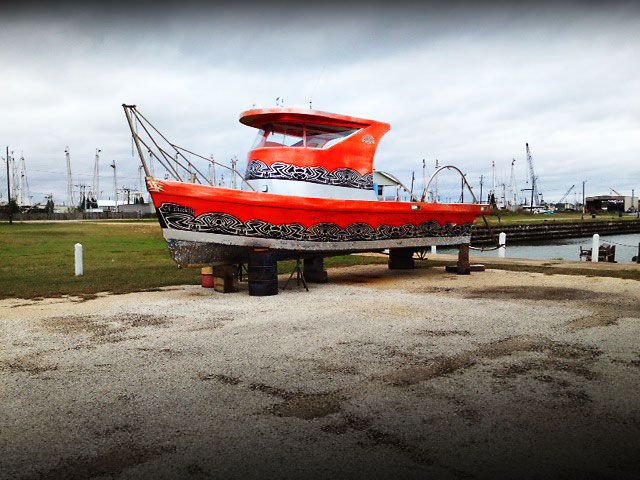
We turned into the town and found a thriving fishing port. There were dozens of commercial fishing boats and processing plants. The port appeared to have been substantially upgraded with areas for RVs and recreation. We noticed that the town had cafes and restaurants that included Mexican, Asian, and American foods. We stopped for lunch where I had quail and shrimp tacos.

On the way out of town we saw a Church compound that looked vaguely asian. At first Jane said it must be Buddhist. But as we got closer, it became clear that it was a Catholic Church - Assumption Chapel - located at 100 Vietnam St.. The street where it was located was extraordinarily neat with large religious figures in almost all the yards. We learned later that the entire area was made up of the Vietnamese who had escaped from the Communists, fought the Ku Klux Klan and built a robust community. It's the American way, I suppose. The Parish of St Anthony of Padua had an Italian saint, the congregations were largely Mexican American, and the Parochial Vicar was Rev. Dominic Trung Nguyen.
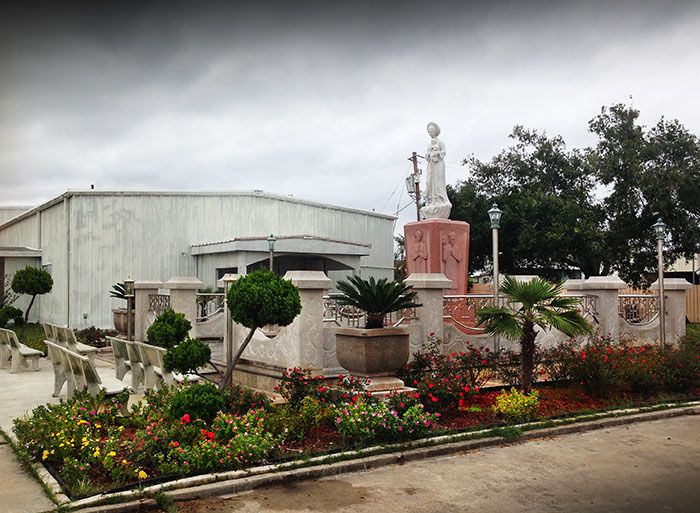
Our journey continued as we headed for Galveston, Texas. We planned to spend the night boon docking on the beach on the Bolivar Peninsula. While on the road we looked ahead at an almost completed communications tower. I thought that I saw something moving on the tower near the top. One of the true pleasures of the TC is that if you see something, you can just pull off the road and take a look. Sure enough, it was a scene worthy of a three ring circus. Three guys, bundled against the cold, freezing, winds were up on that tower guiding in the topmost part. Who knew the things were just bolted together? Jane and I watched through our binoculars, mesmerized by the strength, agility and stamina of those men on the tower. Not to mention their bravery. I just admire working men. Later that night as we were crossing on the Ferry in Galveston, a group of men approached us about the Avion. We spent the whole crossing talking to them. This occurred everywhere we went, and it so happens that we enjoy talking about our TC. Other folks should be warned that the Avion TC is a conversation starter that won't quit. It's like parking a Maserati in front of a Dairy Queen. Or something.You get what I mean.
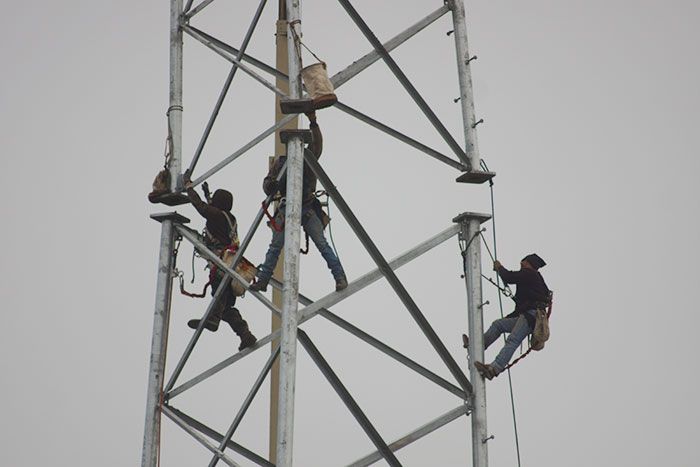
We spent the night at a strange motel on the Bolivar Peninsula. The place was completely empty except for Jane and Me. We awakened in the morning to the sounds of sustained gunfire. Hunting season had arrived. The lady in the motel graciously made us a very good breakfast as part of our $58 fee. All in all it was a nice experience, though I wondered why it was empty and there were no other motels in the area.
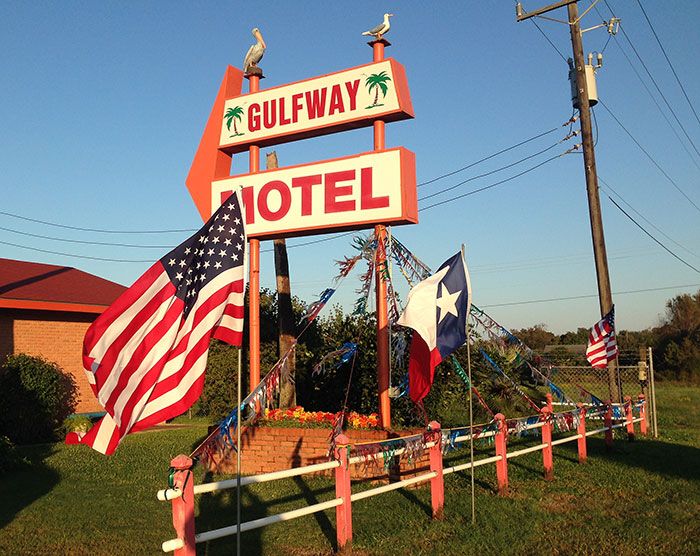
I traveled along the Louisiana - Texas coast as a child. I recall the smell of the oil refineries in Galveston and Corpus Christie. In particular, I remembered a ranch that our friend's relatives had in Cameron Parish, Louisiana. It was directly on the Gulf. They actually had Texas Long Horns and other stock along with chickens, pigs and the rest of a sustainable farm. They died and their ranch was destroyed in 1957 by Hurricane Audrey which left over 400 fatalities in its wake. So, it was with a bit of sadness that I traveled the Louisiana Coast. I remembered the ranch and somehow I remembered the food…a combination of Tex Mex and Cajun with lots of seafood.
Today there is very little left of Cameron Parish along the Gulf. Numerous hurricanes have driven people away, including the blows of Katrina, Ike and Rita. It appears that the last two made direct hits in the area. Now the FEMA regulations allow very restricted construction which is too expensive for most of the local people. Only the rich will live along the Coast.
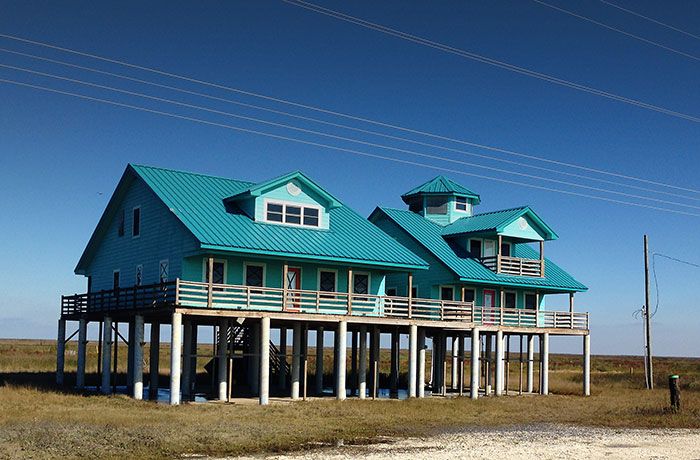
Vermillion Parish is the next one towards New Orleans. We stopped at Pecan Island for coffee in our TC. Its odd about the Spanish Moss. All at once there it is. I marveled at the Live Oaks on this spot just 10 miles from the Gulf. How do they survive?
We had taken up the idea of foraging for our Thanksgiving feast while along the Texas Coast and continued into Louisiana. We spotted roadside stands selling Opelousas Sweet potatoes, Satsumas (?), persimmons and Kumquats (Kumquats?) We gathered them all up in the TC - just imagine pulling off to the side of the road with a fiver. Heh. At another town we found a fresh fish market where we bought humongous Gulf shrimp and fresh Flounder. At another spot a Mexican American was selling "Thanksgiving Tamales". Who knew that tamales were a Thanksgiving delicacy? The fellow selling pecans said that he had read that people eating nuts were less likely to die of any cause, including cancer and heart disease. I bought 2 pounds.

Hurricane Rita obliterated almost all the homes and the local school. Only one business remains in this Cajun town, a store that sells fuel, groceries and hunting supplies. I wonder about the regulations that we place on communities and people today. Without a doubt it prevents losses in storms…but at the cost of destroying a culture that has thrived for 200 years in these swamplands. It won't be Cajun any more.
That night we arrived in NOLA. New Orleans, Louisiana. We parked in the driveway and sagely nodded our heads as the guests - that - need - nothing - at - all - they - bring -their - own - bedroom. (And much of their own food).
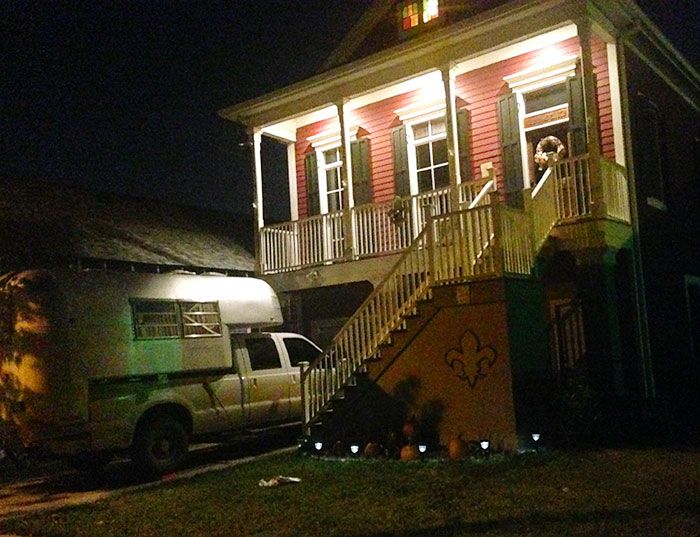
We engaged in a New Orleans tradition on Thanksgiving Day and went to the race track. Since everyone in New Orleans dresses up at the drop of a hat, the races are no exception. All across the grandstands, in the paddock and including the railbirds along the fence, people were strutting. Of course it helps if you're young and cool as opposed to being older and less cool. But, we tried our best. Thats my psychiatrist niece and her artist husband, Sweet Jane and Me at the races. I lost on Street Serenade - she won on Arkansas Martini, ridden by a lady jockey - naturally.
I got a Bloody Mary at the track that was the most elaborate drink I have ever been served. It had practically a bottle of olives, stalks of celery and who knows what else. I think the bartender was a friend of the family. Later, after I recovered, we tucked into a Thanksgiving feast.
For those of you who are wondering, Jane is wearing a "fascinator". There's a whole lot of millinery in New Orleans. Surely Steve and Sally can join us next year. The Brits love hats.
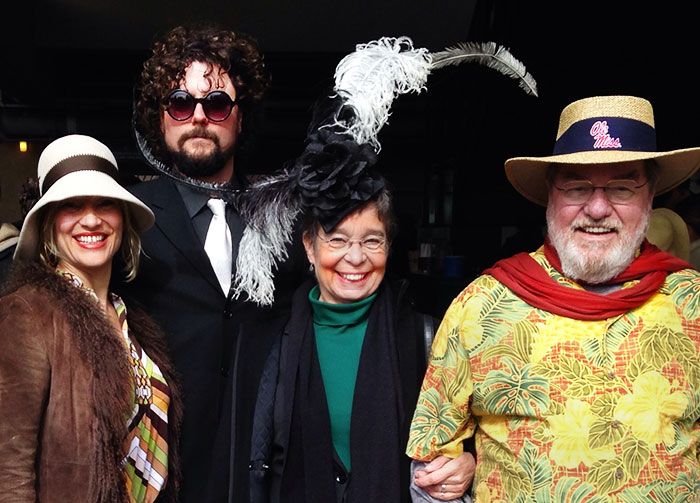
After several days in NOLA we hit the road again, up through my home country of the Mississippi Delta cotton lands. We stopped at the Vicksburg National Military Park. Jane wanted to see the Illinois Monument since she was born and raised in southern Illinois. Many of the Federal units engaged in the battle of Vicksburg were from Illinois. US Grant was decisive in bringing down Vicksburg on July 4, 1863 - the same day that the South lost at Gettysburg.
When I was a schoolchild we had annual trips to the Vicksburg Battlefield Cemetery, Confederate flags fluttering from our school bus windows. At the site, the teachers extolled the valor and sacrifice of our fallen soldiers and the tragedy of the War Between the States. That fervor for the honor of the Old South appears to have gone with the wind.
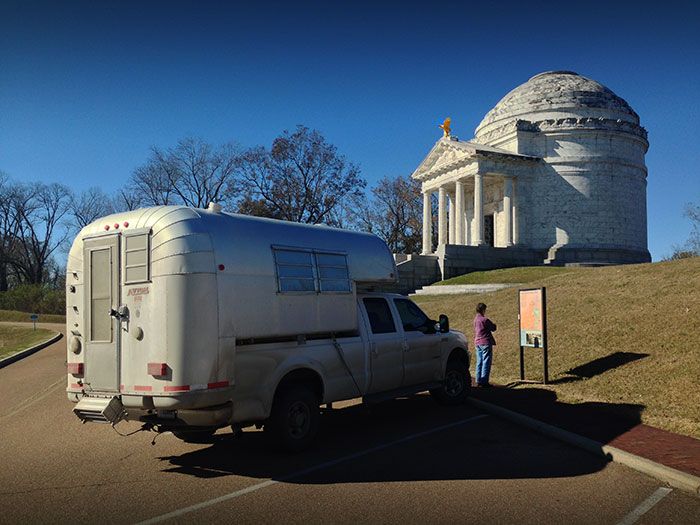
On Highway 61, north of Vicksburg, we ran across a strange lost memorial to some ecstatic vision. These roadside constructions are spotted every so often as you wend the byways of the Mississippi Delta. It is another tribute to the truck camper that we can stop and examine this almost hallucinogenic eruption. And the more you think about it the less judgmental you become. The man who labored for a half century on his vision of heaven is gone. One hopes he found what he saw.

Our last night on the road was near my hometown of Greenville, Mississippi. Greenville is directly on the Mississippi River where it both benefited from the Father of Waters and suffered in the epic flood of 1927. I'm afraid that hard times have come to my town. The stores on the familiar streets near the levee are bedraggled, population has plunged, and almost all of my family has either passed away or moved on.
As we were driving along in Greenville I spotted another bit of road art. It tickled me.
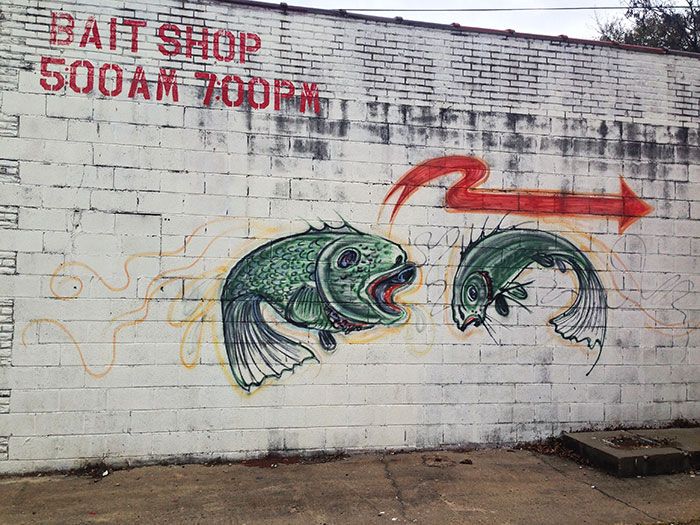
We spent the night at the old Warfield Point outside of Greenville. Its where my parents caught the ferry to Arkansas before there was a bridge. Its also where the river divided into two sections until 1927 when the levees broke and waters spread into the largest flood in American history, inundating cotton lands and forcing people to live atop the remaining levees for many months. The terrible conditions of the refugees was a national disgrace that led to an overhaul of the entire Federal approach to flood control and disaster relief. Herbert Hoover, an engineer who had been successful in dealing with refugees in Europe after WWI became the point person on the relief efforts which led directly to his election as President. We know how that turned out.
Seems like everyone who fools with the Mississippi is snakebit.

I stood on the banks of the river that last night on the road and watched the towboats in the distance. Sweet Jane and I left for home the next morning.
DG
We were interested in some property in far west Texas, and our family was gathering in New Orleans for the holidays. Jane is an elected public official and has to be at City Council meetings every 2-3 weeks, so we seldom have much time for travel. When we plotted out the schedule, it appeared that we were going to cover some 3,000 miles in roughly two weeks. That seemed formidable. After all, the longest trip we've taken with the restored camper was four days, and that was within 200 miles of home. This promised to be an uncompromising shakedown of the truck camper. If anything were to go wrong we would be far from home.
But long range weather forecasts looked good, the property in Texas looked promising, and we remain eternal optimists. Off we went.
The first day was almost 12 hours driving. We arrived at our first destination, Wright Patman Reservoir near Texarkana, Texas. Though we had reservations with the Corps of Engineers RV site, we didn't have a map of the place and wound up driving around in the darkening night. A friendly fisherman actually guided us to our site, otherwise we would have boondocked on someone's dam. Dinner was delicious as was breakfast. One of our agreements on the trip is that we would perform traditional gender roles: Jane was in charge of anything to do with food, furnishings and interiors…I was the mechanic, driver and outside guy. Being a modern feminist, Jane usually rejects this reasoning, but we found it to work very well on the trip. I thought at one point of suggesting that we continue this arrangement in the future. Then my better sense took over…
In the morning I awakened before dawn. The waters in the reservoir were gleaming in the morning light. Things looked promising.

We drove on I 30 through Texas. For those of you who haven't driven in Texas, the freeway has a 75MPH speed limit. And that is just a starting point. Unbelievably the farm roads were posted in many cases at 70MPH.
I had not driven the Avion truck camper for long distances, but I was very favorably impressed. Even at the high speeds, the rig worked well. While I have airbags and other mods for stability, I was struck over and over as to the aerodynamic qualities of the Avion. I have been in flat sided TCs that seemed to be sucked in by passing tractor trailers…swerving all over the road. That did not happen with us.
However, I must warm you that one DOES NOT take advantage of the HOV lanes in Dallas-Fort Worth during morning rush hour. Jane and I still refer to it as the CANYON OF DEATH. It was entirely my fault, as I swerved into the HOV lane, not noticing that it was guarded on both sides by concrete barriers and that the lane dropped off about two inches on either side of the roadway. It was white knuckle time for many miles.
We passed through the oil rich Permian Basin. Unless you've been on another planet, you know by now that there is something called "fracking" going on. However, unless you've been to a fracking area you have no idea how intense the activity is. I mean 24/ 7/ 365, big men with big trucks and fracking wells all over.

It's hard to contemplate the wealth that is being generated, though you can see the houses going up alongside the road. I mean, not in a grand location with lakes, etc. Just along the road - with a heliport in the back yard. This is Texas!

We arrived at our campground southwest of Midland-Odessa, Monahan's Sandhill State Park, before dusk. It was largely empty, so we found our spot and reflected on our luck. It was warm, with a gentle breeze. We ate grilled salmon outside. Let me assure you all that the Texas Parks are superb. The best system that I have seen anywhere. So, we looked forward to a restful night and a good start in the AM.
In the morning I awakened to a beautiful red sky. Completely innocent of weather knowledge I went about my business.
It turns out there is an old saying: "Red skies in the morning, sailor's warning."

We drove towards our destination of Marfa, Texas. The winds were picking up. The realtor in Marfa emailed that they were expecting a severe winter storm that night.
Marfa is a strange phenomenon in the far west Texas mountain country. It's a town of perhaps 3,000 people that has been transformed into an outpost of Brooklyn or Los Angeles. The primary attraction is the the sculpture of Don Judd, who died 20 years ago. Judd purchased half the town as well as an abandoned Army base where he installed his work and that of other artists. Judd was a "minimalist" - who objected to the term, of course. I tend to be attracted to the aesthetic dimensions of minimalism - a profoundly direct approach to materials and ideas. So, the experience for me was very powerful. In addition to Judd's work there is also Dan Flavin's neon sculptures among other artists. The town has galleries and restaurants, but its largely shut down for the first few days of the week. If you go, make sure you eat at the Food Shark. It's a food truck that is open under the pavilion in the middle of town.
Marfa is at least 4 hours away from a city. So, you have to make it a destination. We've become intrigued with the town - and thought that we might find a place for part of the year that would also be a good investment.
Here is Judd's installation at the Army Base. There are many more sculptures outside - the guided tour that includes his home, studio, and other sculptors works, takes much of the day.

Dan Flavin's sculptures

Oddly enough, this out-of-the-way town is where "Giant" was filmed with James Dean, Elizabeth Taylor and Rock Hudson. Recently it has been the site of award winning films like "No Country for Old Men" and "There Will be Blood". Everyone in the movies, including the cast of Giant stayed at the Paisano Hotel. This is the lobby where a good libation can be had. That's my sweet daughter, who lives in Berlin, relaxing last May.

We arrived in Marfa during the day and looked at properties, met with city officials about taxes, etc…all the stuff you do when you're checking out real estate. All day long it cooled, and the temperature lowered. We were busy and didn't pay much attention. We checked into the hipster RV park on the outskirts of Marfa. The winds blew and blew. The heavens howled.

The sleet hit the aluminum Avion like bb's from a shotgun. The wind pushed us back and forth all night. Two things happened that were unanticipated: (1) the Wave 3 heater appeared to only heat up a small amount - just the bottom. And (2) the CO/propane detector went off constantly…no matter what we did. We opened and closed windows. Turned the Wave up and down.
I was thinking that we really hadn't used the heater in a long time and perhaps it had gotten dusty or whatever. But, it didn't matter. We were caught in an ice storm with little heat. I thought of disengaging the detector - maybe something was wrong with it - then I had another thought - better to leave the detector running in case its right than to disarm it - and not find out it was right. I was pleased with my sharp thinking…..

Finally we got into bed with the wonderful goosedown comforters that Jane had brought and rode out the night. it was like being in a tempest in a sailboat. In the morning we got up extra early and headed south to the Mexican border. Unfortunately, there are several high mountains where ice was collecting. The truck started to slide slightly as we neared the passes. I went into 4 wheel drive and creeped along. If we didn't get over the pass we had to return to Marfa where the storm was gathering strength. We might be iced in for days.

We made it Presidio on the Mexican border. It was relatively warm. We decided that it was time to have some huevos rancheros. And yes, they were very good.

We have always been intrigued by the Mexican border. Over the past few years the issue of illegal immigration has been an important topic. Marfa is the center for the Border Patrol and you can see the white vans and trucks everywhere on the landscape. So, we were a little concerned that tooling along the Rio Grande in our Avion camper might be interpreted by the Border Patrol as suspicious activity. We could be carrying a dozen illegals in the camper - or maybe something else. It sort of rattled me to contemplate rap on the door and for the Feds to ask for "your papers, please".
Texas 170 goes alongside the Rio Grande on its way to Big Bend National Park from Presidio. Now there is actually a little confusion: There is also a Big Bend Ranch State Park that runs alongside the Rio Grande and abuts the Federal Big Bend national Park. We didn't go into Big Bend Ranch, but from all accounts it is very primitive and wonderful. The expanse of the two parks together is larger than many of the states in the US, and the danger of this isolation is also big. It seems that every week someone gets lost for days or worse. Its a place to take some care. We took Texas 170 and wondered at the beauty of the area. We were also relieved to leave the storm behind. Jane had always wanted to dip her foot in the Rio Grande, so here was the opportunity:

That's the border folks, and not a Border Patrol guy in sight. In fact all through the Park and for several hundred miles we didn't see any of the ICE guys. Please note the nice green patch across the Rio Grande…that's Mexico.
We made it into Big Bend, but we noted that the weather was cooling again. Without our internet connections, and the radio given over to mostly mariachi, we didn't know what was happening with the storm. But who's worry about that when you're driving through Big Bend country. Its downright amazing.

Huge vistas that photography can't easily convey.

We drove into the town of Terlingua. It's the scene of the world famous chili "cook off" the first week of November. Seems like there was a disagreement between the pro-bean Chili folks and the anti-bean Chili Folks. So, the cook offs are now two distinct events. Too bad we missed it, but it appears that the year's DUI arrests spike in the first week of November. Better that we are here in the last week of November.
I didn't know that the area was opened up in the late 1800s as a result of Mercury mining - "Quicksilver" or "Cinnabar". I think that Mercury contamination can make you crazy. That may explain some of the purported goings on in Terlingua.
We settled down for the night after driving towards Cottonwood and passing the old mining area of Castolon and the sheer walls of Santa Elena Canyon. We were the only ones at Cottonwood Campground. I sort of wondered where everyone was…

That evening, towards dusk, there were three sharp raps on the side of our camper. We couldn't see anyone through the windows. We called out but no one answered. We called again. Of course we had two thoughts: (1) Some illegal immigrants have come across the Rio Grande and they were inviting themselves to dinner or (2) ICE is outside the camper and wants to "see our papers" and inspect the camper. I wanted to go first through the door, sheltering Jane. Of course, Jane, abandoning our agreement about the roles of gender threw the door open first and said, "Who's there?". It turned out to be be an officious National Parks guy who had issues with our paperwork. Jane had packaged our fees correctly, had written up the permits correctly, but had not affixed them to the window correctly. What was a National Parks guy to do in a deserted campground with this level of incompetence? Jane who holds a PhD and the National Parks guy discussed the issue minutely. Finally he was satisfied and left.
We woke up in the morning to a winter wonderland, deep in the heart of Big Bend.

The storm had caught us. We were the only ones who didn't figure it out it appeared. We broke camp and headed for high ground and then to the east with the storm right behind us.
We passed over the Pecos River and the dizzying bridge.

We arrived at Seminole Canyon State Park. We had hoped to see the well known Indian Pictographs that would dazzle Whazoo. It was not to be. The storm made the footing too slippery to travel in the canyon. And to add insult to injury, there was no place within 50 miles to buy a beer or a bottle of wine. Jane cooked a great meal as usual, but here we were alone in a campground, buffeted again by the storms and nothing to ease the pain… I reflected that Silversands would have never allowed this situation to develop. Drat!

On to Goose Island! We traveled to Corpus Christie, Texas the next day on our way to Goose Island State Park. We have both been intrigued by the WPA in the Roosevelt administration and the parks that were created by the Civilian Conservation Corps. The CCC was made up of young out of work men. They lived in military style barracks while working on parks and other construction. Interestingly, most of their pay was sent home to their mama's…a very good idea according to Jane. The Texas Park system was largely started during the Depression and the CCC. They have a special website devoted to the CCC Parks, and Goose Island is one of them. Its in the bay near Corpus Christie and the Aransas Wildlife Preserve that is famous for the Whooping Cranes.
It was cold on Goose Island, but better than the day before. Besides, I had scored wine from a liquor store. Ahem. It's against the rules of the park, but I figured I was a senior citizen and adept at turning wine into water. So, I thought I deserved special privileges.
Our spot was right on the Bay.

We went in the morning to the Aransas Wildlife Preserve. Turns out the headquarters was closed. Not only that, but yet another officious Federal parks guy directs us to put our money into a slot in the building. I sort of questioned our donation to a closed facility, but we went ahead and did it. After all, I was in a better mode having a pleasant dinner with my companion, Cabernet Sauvignon. With no maps and no info we went looking for the elusive Whooping Crane. Yet again, we were alone. The trees on Aransas had been sculpted by the continuous winds.

We spotted a strange contraption of a walk way that took us over the tree tops in our effort to spot the Whooping Crane. We peered here and there with our binoculars. The Whooping Crane story is the Ur story of wildlife preservation. It was almost extinct, along with the Sand Hill Crane, in the middle of the last century. Tremendous efforts were made at preserving these birds and gradually their flocks grew. Now, they travel to Aransas in the winter ahead of the storms to make their home. Ahead of the storms? A Ha! I told Jane to keep a close look out. Mind you we were completely alone on a day that the park was essentially closed…and what did we see? We saw a pair of Whooping Cranes floating in the sky and landing nearby.
Ha. Usually the tourists have to pay some dude in a boat $100 for the "wildlife tour" to see the Cranes. This picture is from the Aransas website.

Traveling along the Texas Coast we entered the town of Palacios. I saw brightly colored shrimp boats and recalled to Jane that I remember that Vietnamese fishermen had settled on the Gulf coast after escaping the Communist regime in Vietnam. They started fishing for shrimp which, ironically, led to gunfights at sea with Ku Klux Klansmen over disputed fishing waters.

We turned into the town and found a thriving fishing port. There were dozens of commercial fishing boats and processing plants. The port appeared to have been substantially upgraded with areas for RVs and recreation. We noticed that the town had cafes and restaurants that included Mexican, Asian, and American foods. We stopped for lunch where I had quail and shrimp tacos.

On the way out of town we saw a Church compound that looked vaguely asian. At first Jane said it must be Buddhist. But as we got closer, it became clear that it was a Catholic Church - Assumption Chapel - located at 100 Vietnam St.. The street where it was located was extraordinarily neat with large religious figures in almost all the yards. We learned later that the entire area was made up of the Vietnamese who had escaped from the Communists, fought the Ku Klux Klan and built a robust community. It's the American way, I suppose. The Parish of St Anthony of Padua had an Italian saint, the congregations were largely Mexican American, and the Parochial Vicar was Rev. Dominic Trung Nguyen.

Our journey continued as we headed for Galveston, Texas. We planned to spend the night boon docking on the beach on the Bolivar Peninsula. While on the road we looked ahead at an almost completed communications tower. I thought that I saw something moving on the tower near the top. One of the true pleasures of the TC is that if you see something, you can just pull off the road and take a look. Sure enough, it was a scene worthy of a three ring circus. Three guys, bundled against the cold, freezing, winds were up on that tower guiding in the topmost part. Who knew the things were just bolted together? Jane and I watched through our binoculars, mesmerized by the strength, agility and stamina of those men on the tower. Not to mention their bravery. I just admire working men. Later that night as we were crossing on the Ferry in Galveston, a group of men approached us about the Avion. We spent the whole crossing talking to them. This occurred everywhere we went, and it so happens that we enjoy talking about our TC. Other folks should be warned that the Avion TC is a conversation starter that won't quit. It's like parking a Maserati in front of a Dairy Queen. Or something.You get what I mean.

We spent the night at a strange motel on the Bolivar Peninsula. The place was completely empty except for Jane and Me. We awakened in the morning to the sounds of sustained gunfire. Hunting season had arrived. The lady in the motel graciously made us a very good breakfast as part of our $58 fee. All in all it was a nice experience, though I wondered why it was empty and there were no other motels in the area.

I traveled along the Louisiana - Texas coast as a child. I recall the smell of the oil refineries in Galveston and Corpus Christie. In particular, I remembered a ranch that our friend's relatives had in Cameron Parish, Louisiana. It was directly on the Gulf. They actually had Texas Long Horns and other stock along with chickens, pigs and the rest of a sustainable farm. They died and their ranch was destroyed in 1957 by Hurricane Audrey which left over 400 fatalities in its wake. So, it was with a bit of sadness that I traveled the Louisiana Coast. I remembered the ranch and somehow I remembered the food…a combination of Tex Mex and Cajun with lots of seafood.
Today there is very little left of Cameron Parish along the Gulf. Numerous hurricanes have driven people away, including the blows of Katrina, Ike and Rita. It appears that the last two made direct hits in the area. Now the FEMA regulations allow very restricted construction which is too expensive for most of the local people. Only the rich will live along the Coast.

Vermillion Parish is the next one towards New Orleans. We stopped at Pecan Island for coffee in our TC. Its odd about the Spanish Moss. All at once there it is. I marveled at the Live Oaks on this spot just 10 miles from the Gulf. How do they survive?
We had taken up the idea of foraging for our Thanksgiving feast while along the Texas Coast and continued into Louisiana. We spotted roadside stands selling Opelousas Sweet potatoes, Satsumas (?), persimmons and Kumquats (Kumquats?) We gathered them all up in the TC - just imagine pulling off to the side of the road with a fiver. Heh. At another town we found a fresh fish market where we bought humongous Gulf shrimp and fresh Flounder. At another spot a Mexican American was selling "Thanksgiving Tamales". Who knew that tamales were a Thanksgiving delicacy? The fellow selling pecans said that he had read that people eating nuts were less likely to die of any cause, including cancer and heart disease. I bought 2 pounds.

Hurricane Rita obliterated almost all the homes and the local school. Only one business remains in this Cajun town, a store that sells fuel, groceries and hunting supplies. I wonder about the regulations that we place on communities and people today. Without a doubt it prevents losses in storms…but at the cost of destroying a culture that has thrived for 200 years in these swamplands. It won't be Cajun any more.
That night we arrived in NOLA. New Orleans, Louisiana. We parked in the driveway and sagely nodded our heads as the guests - that - need - nothing - at - all - they - bring -their - own - bedroom. (And much of their own food).

We engaged in a New Orleans tradition on Thanksgiving Day and went to the race track. Since everyone in New Orleans dresses up at the drop of a hat, the races are no exception. All across the grandstands, in the paddock and including the railbirds along the fence, people were strutting. Of course it helps if you're young and cool as opposed to being older and less cool. But, we tried our best. Thats my psychiatrist niece and her artist husband, Sweet Jane and Me at the races. I lost on Street Serenade - she won on Arkansas Martini, ridden by a lady jockey - naturally.
I got a Bloody Mary at the track that was the most elaborate drink I have ever been served. It had practically a bottle of olives, stalks of celery and who knows what else. I think the bartender was a friend of the family. Later, after I recovered, we tucked into a Thanksgiving feast.
For those of you who are wondering, Jane is wearing a "fascinator". There's a whole lot of millinery in New Orleans. Surely Steve and Sally can join us next year. The Brits love hats.

After several days in NOLA we hit the road again, up through my home country of the Mississippi Delta cotton lands. We stopped at the Vicksburg National Military Park. Jane wanted to see the Illinois Monument since she was born and raised in southern Illinois. Many of the Federal units engaged in the battle of Vicksburg were from Illinois. US Grant was decisive in bringing down Vicksburg on July 4, 1863 - the same day that the South lost at Gettysburg.
When I was a schoolchild we had annual trips to the Vicksburg Battlefield Cemetery, Confederate flags fluttering from our school bus windows. At the site, the teachers extolled the valor and sacrifice of our fallen soldiers and the tragedy of the War Between the States. That fervor for the honor of the Old South appears to have gone with the wind.

On Highway 61, north of Vicksburg, we ran across a strange lost memorial to some ecstatic vision. These roadside constructions are spotted every so often as you wend the byways of the Mississippi Delta. It is another tribute to the truck camper that we can stop and examine this almost hallucinogenic eruption. And the more you think about it the less judgmental you become. The man who labored for a half century on his vision of heaven is gone. One hopes he found what he saw.

Our last night on the road was near my hometown of Greenville, Mississippi. Greenville is directly on the Mississippi River where it both benefited from the Father of Waters and suffered in the epic flood of 1927. I'm afraid that hard times have come to my town. The stores on the familiar streets near the levee are bedraggled, population has plunged, and almost all of my family has either passed away or moved on.
As we were driving along in Greenville I spotted another bit of road art. It tickled me.

We spent the night at the old Warfield Point outside of Greenville. Its where my parents caught the ferry to Arkansas before there was a bridge. Its also where the river divided into two sections until 1927 when the levees broke and waters spread into the largest flood in American history, inundating cotton lands and forcing people to live atop the remaining levees for many months. The terrible conditions of the refugees was a national disgrace that led to an overhaul of the entire Federal approach to flood control and disaster relief. Herbert Hoover, an engineer who had been successful in dealing with refugees in Europe after WWI became the point person on the relief efforts which led directly to his election as President. We know how that turned out.
Seems like everyone who fools with the Mississippi is snakebit.

I stood on the banks of the river that last night on the road and watched the towboats in the distance. Sweet Jane and I left for home the next morning.
DG
Labels:
- Labels:
-
Truck Campers
34 REPLIES 34
Options
- Mark as New
- Bookmark
- Subscribe
- Mute
- Subscribe to RSS Feed
- Permalink
- Report Inappropriate Content
Dec-03-2013 11:07 AM
Fantastic adventure -- and your TC appears to be serving you well.
Cal
Options
- Mark as New
- Bookmark
- Subscribe
- Mute
- Subscribe to RSS Feed
- Permalink
- Report Inappropriate Content
Dec-03-2013 11:02 AM
I saw brightly colored shrimp boats and recalled to Jane that I remember that Vietnamese fishermen had settled on the Gulf coast after escaping the Communist regime in Vietnam.
Great travel report. Having lived in Texas and traveled it end to end and top to bottom, it was a pleasure reviewing through your pictures and dialogue.
I lived in SE Texas and worked out of Port Arthur back in the 90's. One of a few towns that I have heard that had very little need for an animal shelter for strays.
We would buy fresh caught shrimp on the side of the highway south of Port Arthur.
On another note, I traveled to and from Pennsylvania over the Thanksgiving weekend (2,560 miles in 44-1/2 hours - 2 drivers) and saw a nice Avion TC mounted on a dark colored Ford P/U Friday morning on I-81 in either TN, VA, West VA, or MD (who can remember?).
Options
- Mark as New
- Bookmark
- Subscribe
- Mute
- Subscribe to RSS Feed
- Permalink
- Report Inappropriate Content
Dec-03-2013 10:51 AM
great trip, thanks for sharing..
2011 Lance 855
3.5# Minpin named Darcy RIP
Ford F250 Super Duty
3.5# Minpin named Darcy RIP
Ford F250 Super Duty
Options
- Mark as New
- Bookmark
- Subscribe
- Mute
- Subscribe to RSS Feed
- Permalink
- Report Inappropriate Content
Dec-03-2013 10:46 AM
We are planning to head down to the coast at some point in the next year as well..thanks for the write up on your adventure!
JB
JB
2014 V3305 Dutchmen Voltage TH
2014 F450 Platinum
2009 F250 Diesel**sold**
Can Am Commander 1000XT
2014 F450 Platinum
2009 F250 Diesel**sold**
Can Am Commander 1000XT
Options
- Mark as New
- Bookmark
- Subscribe
- Mute
- Subscribe to RSS Feed
- Permalink
- Report Inappropriate Content
Dec-03-2013 10:36 AM
What an utterly delightful post! Thanks so much for taking the time to share it. My late husband and I RV-ed a lot in TX and loved it. Do you have photos of the interior of your camper? It's really special!
2015 Tiger Bengal TX 4X4
Chevy 3500HD, 6L V8
Chevy 3500HD, 6L V8





